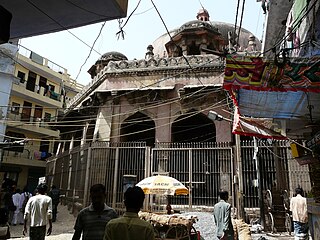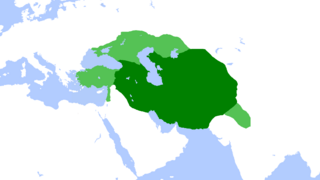
The Delhi Sultanate or the Sultanate of Delhi was a late medieval empire primarily based in Delhi that stretched over large parts of the Indian subcontinent, for more than three centuries. The sultanate was established around c. 1206–1211 in the former Ghurid territories in India. The sultanate's history is generally divided into five periods: Mamluk (1206–1290), Khalji (1290–1320), Tughlaq (1320–1414), Sayyid (1414–1451), and Lodi (1451–1526). It covered large swaths of territory in modern-day India, Pakistan, Bangladesh, as well as some parts of southern Nepal.

Multan is a city in Punjab, Pakistan, located on the bank of river Chenab. It is one of the five largest urban centres of Pakistan in 2024 and is the administrative centre of Multan Division. It is a major cultural, religious and economic centre of Punjab region, Multan is one of the oldest cities of Asia with a history stretching deep into antiquity.

The Chagatai Khanate, also known as the Chagatai Ulus, was a Mongol and later Turkicized khanate that comprised the lands ruled by Chagatai Khan, second son of Genghis Khan, and his descendants and successors. At its height in the late 13th century the khanate extended from the Amu Darya south of the Aral Sea to the Altai Mountains in the border of modern-day Mongolia and China, roughly corresponding to the area once ruled by the Qara Khitai.

Bahlul Khan Lodi was the chief of the Afghan Lodi tribe. Founder of the Lodi dynasty from the Delhi Sultanate upon the abdication of the last claimant from the previous Sayyid rule. Bahlul became sultan of the dynasty on 19 April 1451.

The Tughlaq dynasty was the third dynasty to rule over the Delhi Sultanate in medieval India. Its reign started in 1320 in Delhi when Ghazi Malik assumed the throne under the title of Ghiyath al-Din Tughluq and ended in 1413.

The Lodi dynasty was an Afghan royal family that ruled Sultanate of Delhi from 1451 to 1526. It was the fifth and final dynasty of the Delhi Sultanate, and was founded by Bahlul Khan Lodi when he replaced the Sayyid dynasty.

Ghiyath al-Din Tughluq, or Ghazi Malik was the Sultan of Delhi from 1320 to 1325. He was the first sultan of the Tughluq dynasty of the Delhi Sultanate. During his reign, Ghiyath al-Din Tughluq founded the city of Tughluqabad. His reign ending upon his death in 1325 when a pavilion built in his honour collapsed. The 14th century historian Ibn Battuta claimed that the death of the sultan was the result of a conspiracy against him.
Khokhar is a historical Punjabi tribe primarily native to the Pothohar Plateau of Pakistani Punjab. Khokhars are also found in the Indian states of Punjab and Haryana. Khokhars predominantly follow Islam, having converted to Islam from Hinduism after coming under the influence of Baba Farid.

Khizr Khan was the founder of the Sayyid dynasty, the fourth ruling dynasty of the Delhi sultanate, in northern India soon after the invasion of Timur and the fall of the Tughlaq dynasty. Khizr Khan was Governor of Multan under the Tughlaq ruler, Firuz Shah Tughlaq, and was known to be an able administrator. He did not take up any royal title due to fear of invasion by Amir Timur and contended himself with the titles of Rayat-i-Ala and Masnad-i-Aali or. During his reign, coins were continued to be struck in the name of previous Tughlaq rulers. After his death on 20 May 1421, he was succeeded by his son Mubarak Khan, who took the title of Muizz-ud-Din Mubarak Shah.

The Jaunpur Sultanate was a late medieval Indian Muslim state which ruled over much of what is now the states of Uttar Pradesh and Bihar between 1394 and 1494. It was founded in 1394 by Khwajah-i-Jahan Malik Sarwar, an eunuch slave and former wazir of Sultan Nasiruddin Muhammad Shah IV Tughluq, amidst the disintegration of the Delhi Sultanate's Tughlaq dynasty. Centred in Jaunpur, the Sultanate extended authority over a large part of the Ganges-Yamuna Doab. It reached its greatest height under the rule of Sultan Ibrahim Shah, who also vastly contributed to the development of Islamic education in the Sultanate. In 1494, Sultan Hussain Khan was defeated by the forces of the Afghan ruler Bahlul Lodi, Sultan of the Lodi dynasty of the Delhi Sultanate at Benares at which point Hussain fled to Kahalgaon in modern-day Bihar where the Sultan of Bengal assigned him a pargana. Here he was allowed to mint his own coins and was promised help from Bengal in recovering his kingdom. He died in 1505.
The Farooqi dynasty or the Farooq Shahi was the ruling dynasty of the Khandesh Sultanate from its inception in 1382 till its annexation by the Mughal emperor Akbar in 1601. The founder of the dynasty, Malik Ahmad participated in a rebellion against the Bahmani ruler Muhmmad Shah I in his early years. When he was compelled to flee from Deccan, he established in Thalner on the Tapti River. After receiving the grant of the fiefdoms of Thalner and Karanda from Firuz Shah Tughluq in 1370, he conquered the region around Thalner, which later became known as Khandesh. By 1382, he started ruling independently.
Multan in Punjab province of Pakistan is one of the oldest cities of South Asia, though its exact age has yet to be determined. Multan is known for its rich ancient heritage and historic landmarks. Multan was the capital and largest city of Punjab region in late ancient and most of the medieval era. Multan region was centre of many civilizations in its 5 millenia old history, and witnessed warfare across millennia because of its location on a major invasion route between South and Central Asia.

Kotla Mubarakpur, a medieval famous urban village, is a market place with residential colony in South central part of New Delhi. Kotla Mubarakpur classified by the Delhi Development Authority (D.D.A.) as an Urban Village which is dominated by Baisla gotra of Gurjars, it is situated within touching distance of South Extension. Defence Colony lies to its east. Nearest Delhi Metro stations are South Extension, Dilli Haat - INA and Lajpat Nagar. Its history can be traced to the prominent tomb of Muizud Din Mubarak Shah, son of Khizr Khan of the Sayyid dynasty of the fifteenth century Delhi Sultanate rule in India, and its adjoining mosque. There are several other tombs of Lodi Dynasty period such as the Darya Khan's tomb, Kale Khan ka Gumbad, Bare Khan ka Gumbad, Chote Khan Ka Gumbad and Bhure Khan ka Gumbad, and also a Baoli.

Nasir-ud-Din Mahmud Shah, also known as Nasiruddin Mohammad Shah, was the last sultan of the Tughlaq dynasty to rule the Delhi Sultanate.
Deval Devi was the daughter of Karan Deva II. She was married to Khizr Khan, the eldest son of Alauddin Khalji, in 1308. Eight years later, Khizr Khan was executed by his brother Qutb ud din Mubarak Shah, and Deval was taken into the latter's harem. In 1320, Mubarak in turn was stabbed and beheaded by his supposed favourite, Khusro Khan, and his followers. Deval was then married to Khusro Khan. Her story, of being passed from hand to hand amongst a series of ambitious, power-hungry Muslim men is the basis of the celebrated Gujarati historical novel Karan Ghelo authored by Nandshankar Mehta.

Muizuddin Muhammad Mubarak Shah was the second monarch of the Sayyid dynasty which ruled the Delhi Sultanate.
Jasrat was a 15th-century Punjabi Muslim ruler of Sialkot from 1410 until his death in 1442.

The Timurid conquests and invasions started in the seventh decade of the 14th century with Timur's control over Chagatai Khanate and ended at the start of the 15th century with the death of Timur. Due to the sheer scale of Timur's wars, and the fact that he was generally undefeated in battle, he has been regarded as one of the most successful military commanders of all time. These wars resulted in the supremacy of Timur over Central Asia, Persia, the Caucasus, the Levant, and parts of South Asia and Eastern Europe, and also the formation of the short-lived Timurid Empire.

The Multan Sultanate was a late medieval sultanate based in the Punjab region in the western Indian subcontinent between the 15th and 16th centuries. It was the dominant power of the lower Doab tract with Multan at its centre. The Multan Sultanate was annexed by the Sindh Sultanate in 1527 but had autonomous authority until its merger with the Mughal Empire in 1530.
The rebellion of Ismail Mukh took place between 1346 and 1347 when Deccani Amirs placed Ismail Mukh, also known as Nasir-ud-din Ismail Shah, an Afghan noble, at the head of a rebellion centered at Daulatabad. The rebellion saw the decline and loss of the Delhi Sultanate's control over the Deccan, which had been a part of the Delhi Sultanate since the Khilji dynasty. Ismail Mukh abdicated in favor of Zafar Khan on 3 August 1347, which saw the establishment of the Bahmani Sultanate, which went on to exist until 1518.



















